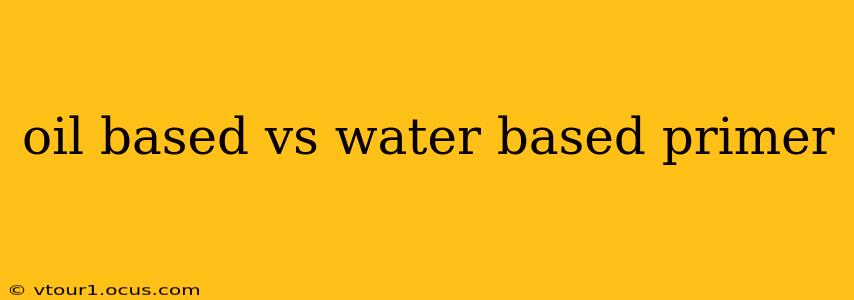Choosing the right primer is crucial for a successful paint job. The battle between oil-based and water-based primers often leaves DIYers and professionals alike scratching their heads. Both offer advantages, but understanding their key differences will help you select the best option for your specific needs. This comprehensive guide breaks down the pros and cons of each, answering common questions to help you make an informed decision.
What are the Key Differences Between Oil-Based and Water-Based Primers?
The most fundamental difference lies in their solvent: oil-based primers use mineral spirits or solvents, while water-based primers, as the name suggests, use water. This difference significantly impacts their properties, application, and suitability for various surfaces and projects.
What are the Advantages of Oil-Based Primer?
Oil-based primers boast several advantages, making them a preferred choice in certain situations:
- Superior adhesion: Oil-based primers offer excellent adhesion to a wide range of surfaces, including glossy or previously painted surfaces. They penetrate deeper, creating a stronger bond with the underlying material.
- Excellent stain blocking: Their thick, penetrating nature makes them ideal for blocking stubborn stains like watermarks, grease, or tannin bleed-through from wood.
- Durability: Once cured, oil-based primers offer superior durability and resistance to wear and tear, making them a great choice for high-traffic areas.
- Smooth finish: They can create a very smooth, even surface for top coats, particularly beneficial when painting woodwork or trim.
What are the Disadvantages of Oil-Based Primer?
Despite their strengths, oil-based primers also present drawbacks:
- Strong odor: They have a strong, pungent odor that can linger for a considerable time after application. Proper ventilation is essential.
- Longer drying time: They take significantly longer to dry than water-based primers, extending project timelines.
- Cleanup: Cleanup requires mineral spirits or solvents, adding an extra step and potentially posing environmental concerns.
- Flammable: Oil-based products are flammable, requiring extra caution during storage and application.
What are the Advantages of Water-Based Primer?
Water-based primers have gained significant popularity due to their ease of use and environmental friendliness:
- Low odor: They are significantly lower in odor compared to oil-based alternatives, making them more pleasant to work with.
- Faster drying time: Water-based primers dry much faster, allowing for quicker project completion.
- Easy cleanup: Cleanup is simple with soap and water, eliminating the need for harsh solvents.
- Environmentally friendly: Water-based primers are considered more environmentally friendly due to their lower VOC (volatile organic compound) content.
What are the Disadvantages of Water-Based Primer?
While water-based primers offer many benefits, they also have some limitations:
- Less stain-blocking power: They might not be as effective at blocking stubborn stains as oil-based primers. Multiple coats might be necessary.
- Potential for raising the grain: On porous surfaces like wood, they can raise the grain, requiring sanding before topcoating.
- Less durable on glossy surfaces: They may not adhere as well to glossy surfaces compared to oil-based primers, potentially requiring extra surface preparation.
Which Primer is Best for Interior Walls?
For interior walls, water-based primers are generally the preferred choice. Their low odor, fast drying time, and easy cleanup make them ideal for home use. However, if you're dealing with significant stains, an oil-based primer might be necessary.
Which Primer is Best for Exterior Surfaces?
For exterior surfaces, the choice is more nuanced. While water-based primers are increasingly popular due to their environmental benefits and ease of application, oil-based primers might offer better durability and stain blocking in harsh weather conditions. Consider the specific climate and surface material.
Which Primer is Best for Wood?
For wood, both oil-based and water-based primers can work well, but the choice depends on the type of wood and the project's requirements. Oil-based primers offer superior stain blocking, while water-based primers are easier to clean up and dry faster. If the wood is prone to tannin bleed-through, an oil-based primer is the better choice.
Which Primer is Best for Metal?
For metal surfaces, an oil-based primer often provides superior adhesion and corrosion resistance. However, water-based primers formulated for metal are also available and offer a more convenient option.
How do I choose the right primer for my project?
Consider these factors when choosing a primer:
- Surface type: Wood, metal, plaster, previously painted surfaces all have different needs.
- Type of paint: Choose a primer compatible with your chosen paint (e.g., oil-based primer for oil-based paint).
- Stain level: Evaluate the level of staining or imperfections that need to be addressed.
- Environmental concerns: Consider the VOC content if you're environmentally conscious.
- Drying time: Account for the drying time needed within your project schedule.
By carefully considering these factors, you can confidently select the appropriate primer for your next painting project, ensuring a flawless and long-lasting finish.
